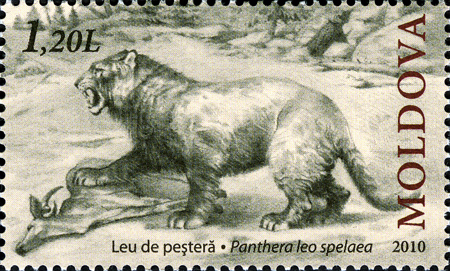Panthera leo Linnaeus, 1758

Phylum: Chordata Haeckel, 1874
Subphylum: Vertebrata Cuvier, 1812
Classe: Mammalia Linnaeus, 1758
Ordine: Carnivora Bowdich, 1821
Famiglia: Felidae Fischer von Waldheim, 1817
Genere: Panthera Oken, 1816
Italiano: Leone delle caverne, Leone delle caverne europeo, Leone delle caverne eurasiatico
English: Eurasian cave lion, European cave lion
Français: Lion des cavernes
Deutsch: Höhlenlöwe
Español: León de las cavernas
Descrizione
Questo felino fu uno dei più grandi di tutti i tempi, visse e si estinse nel Pleistocene. Resti del leone delle caverne indicano che era lungo 3,5 m (10% più lungo dei più grandi leoni africani), grande quanto il suo contemporaneo leone americano, ma più piccolo del contemporaneo orso delle caverne. È normalmente considerato una sottospecie del leone, con il nome scientifico di Panthera leo spelaea (che significa "leone delle caverne" in latino); ma è stato occasionalmente considerato una specie a sé stante con il nome di Panthera spelaea. Alcuni autori, basandosi sulla comparazione dei teschi, considerano il leone delle caverne più vicino alla tigre, il che porterebbe al nome formale di Panthera tigris spelaea. Tuttavia, recenti studi genetici mostrano che fu un vicino, ma distinto parente del leone moderno. Infatti il leone delle caverne avrebbe un antenato comune con i leoni attuali, ma la sua linea evolutiva andò incontro all'estinzione.
Diffusione
Europa, Pleistocene superiore.
Bibliografia
–Karlheinz Fischer: Ein Löwenskelett (Panthera spelaea, Goldfuß, 1810) aus den interglazialen Sedimenten Saale-Zeit von Neumark-Nord bei Merseburg. Dietrich Mania u. a. (Hrsg.): Neumark-Nord – Ein interglaziales Ökosystem des mittelpaläolithischen Menschen. Veröffentlichungen des Landesmuseums für Vorgeschichte in Halle 62. Halle/Saale, 2010, S. 339-360.
–Alessio Iannucci, Beniamino Mecozzi, Antonio Pineda, Raffaele Sardella, Marco Carpentieri, Rivka Rabinovich, Marie-Hélène Moncel: Early occurrence of lion (Panthera spelaea) at the Middle Pleistocene Acheulean site of Notarchirico (MIS 16, Italy). In: Journal of Quaternary Science., 2024.
–Alexander T. Salis, Sarah C. E. Bray, Michael S. Y. Lee, Holly Heiniger, Ross Barnett, James A. Burns, Vladimir Doronichev, Daryl Fedje, Liubov Golovanova, C. Richard Harington, Bryan Hockett, Pavel Kosintsev, Xulong Lai, Quentin Mackie, Sergei Vasiliev, Jacobo Weinstock, Nobuyuki Yamaguchi, Julie Meachen, Alan Cooper, Kieren J. Mitchell: Lions and brown bears colonized North America in multiple synchronous waves of dispersal across the Bering Land Bridge. In: Molecular Ecology. 31 (24), 2022, S. 6407-6421.
–R. Barnett, B. Shapiro, I. Barnes, S. Y. Ho, J. Burger, N. Yamaguchi, T. F. Higham, H. T. Wheeler, W. Rosendahl, A. V. Sher, M. Sotnikova, T. Kuznetsova, G. F. Baryshnikov, L. D. Martin, C. R. Harington, J. A. Burns, A. Cooper: Phylogeography of lions (Panthera leo ssp.) reveals three distinct taxa and a late Pleistocene reduction in genetic diversity. In: Molecular Ecology. 18 (8), 2009, S. 1668-1677.
–Cajus G. Diedrich: Steppe lion remains imported by Ice Age spotted hyenas into the Late Pleistocene Perick Caves hyena den in northern Germany. In: Quaternary Research. 71 (3), 2009, S. 361-374.
–Cajus G. Diedrich: A diseased Panthera leo spelaea (Goldfuss 1810) lioness from a forest elephant graveyard in the Late Pleistocene (Eemian) interglacial lake at Neumark-Nord, central Germany. In: Historical Biology. 23 (2–3), 2011, S. 195-217.
–C. G. Diedrich, K. Zak: Prey deposits and den sites of the Upper Pleistocene hyena Crocuta crocuta spelaea (Goldfuss, 1823) in horizontal and vertical caves of the Bohemian Karst (Czech Republic). In: Bulletin of Geosciences. 81, 4, 2006, S. 237-276.
–Martina Pacher: Funde des Höhlenlöwen (Panthera leo spelaea) aus der Herdengelhöhle (1823/4) bei Lunz am See, Niederösterreich. In: Die Höhle. 60 (1-4), 2009, S. 21-27.
–Wighart von Koenigswald. Erich Schmitt: Eine pathologisch veränderte Löwentibia aus dem Jungpleistozän der nördlichen Oberrheinebene. In: Natur und Museum. 117 (9), 1987, S. 272-277.
–M. Sabo, A. Tomašových und J. Gullár: Geographic and temporal variability in Pleistocene lion-like felids: Implications for their evolution and taxonomy. In: Palaeontologia Electronica. 25 (2), 2022, S. a26.
–O. F. Chernova, I. V. Kirillova, B. Shapiro, F. K. Shidlovskiy, A. E. R. Soares, V. A. Levchenko, F. Bertuch: Morphological and genetic identification and isotopic study of the hair of a cave lion (Panthera spelaea Goldfuss, 1810) from the Malyi Anyui River (Chukotka, Russia). In: Quaternary Science Reviews. 142, 2016, S. 61-73.
–O. F. Chernova, A. V. Protopopov, G. G. Boeskorov, I. S. Pavlov, V. V. Plotnikov, N. Suzuki: First Description of the Fur of Two Cubs of Fossil Cave Lion Panthera spelaea (Goldfuss, 1810) Found in Yakutia in 2017 and 2018. In: Doklady Biological Sciences. 492, 6. Juli 2020, S. 93-98.
–Wighart von Koenigswald, Martin Walders, Martin Sander: Jungpleistozäne Tierfährten aus der Emscher-Niederterrasse von Bottrop-Welheim. In: Münchner Geowissenschaftliche Abhandlungen A. 27 1995, S. 5-50.
–Wighart von Koenigswald, Martin Sanders, Martin Walders: The Upper Pleistocene Tracksite Bottrop-Welheim (Germany). In: Acta Zoologica Cracoviensia. 39, 1996, S. 235-244.
–Cajus G. Dietrich: Late Pleistocene steppe lionPanthera leo spelaea (Goldfuss, 1810) footprints and bone records from open air sites in northern Germanye. Evidence of hyena-lion antagonism and scavenging in Europe. In: Quaternary Science Reviews. 30, 2011, S. 1883-1906.
–Hervé Bocherens, Dorothée G. Drucker, Dominique Bonjean, Anne Bridault, Nicholas J. Conard, Christophe Cupillard, Mietje Germonpré, Markus Höneisen, Susanne C. Münzel, Hannes Napierala, Marylène Patou-Mathis, Elisabeth Stephan, Hans-Peter Uerpmann, Reinhard Ziegler: Isotopic evidence for dietary ecology of cave lion (Panthera spelaea) in North-Western Europe: Prey choice, competition and implications for extinction. In: Quaternary International. 245, 2011, S. 249-261.
–Narimane Chatar, Margot Michaud, Valentin Fischer: Not a Jaguar after all? Phylogenetic Affinities and Morphology of the Pleistocene felid Panthera gombaszoegensis. In: Papers in Palaeontology. 8 (5), 2022, S. e1464.

|
Data: 30/11/2010
Emissione: Animali preistorici Stato: Moldova Nota: Emesso in minifoglio di 10 v. uguali |
|---|